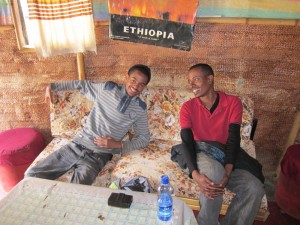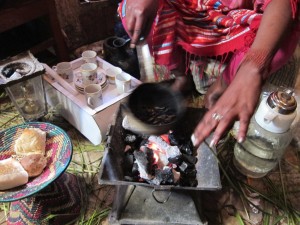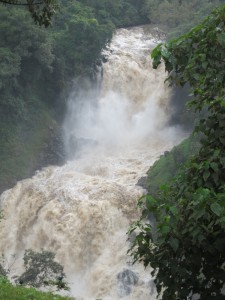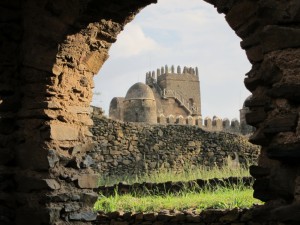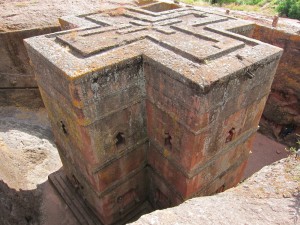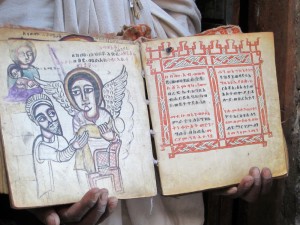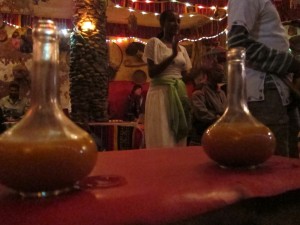Traveling in Ethiopia was a surprising and gratifying adventure highlighted by welcoming locals, adventurous traditional cuisine, amazing nature, the best coffee ever and an eye opening glimpse into the challenges many Ethiopians face today. It was also a challenge to keep an open mind and heart to the welcoming people, when it required a tough filter after often being approached to give money or buy something when walking around. The following post highlights my travels around the country, and in a separate post I will highlight my Simien Mountain trek, an epic trip in its own right. Here are the pictures.
My trip into Addis Ababa from Dar es Salaam went smoothly, until I got into the taxi ride to the hostel. I was nervous about entering a new city, at night, without knowledge of Arhrmaic. The driver had difficulty finding the place I planned to stay, even though I showed him the map in the guidebook. He kept getting out to ask people. I had no idea if we were close or not and the minutes driving around grew tense. He even left the car at one point with it running, and my fantasies ran wild about getting abducted. I had no idea what was going on as he didn’t speak English. He was frustrated and wanted more money. He ended up navigating me to the wrong guest house; he dialed the wrong number in the guidebook I showed him. I decided to call it a night where he dropped me off. The owners of the Henock guest house didn’t speak English either, although we figured out how to get me into a room. Ok. Deep breaths. Welcome to Ethiopia.
The next day I moved to the more centrally located Piazza, which is backpacker central. This area was ideal for getting supplies for the Simien trek and experiencing the city. There were a lot of locals (many shady) outside the hostel interested in helping faranjis (foreigners) out at the hopes of getting some cash, alcohol or food. I needed hiking boots since I shipped mine home after Kilimanjaro, not planning on any further treks. I told a couple of eager locals, Jeremy and Josh (anglicized names for faranji convenience) what I was looking for and they took me to a couple shops, translated for me and I eventually got some for a good price. Then I took them out to lunch to say thank you, and I had my first injera in Ethiopia. It had been years since I had Ethiopian food, and it was really nice to have authentic traditional food with some locals.
Afterwards they took me to a coffee house where some locals hung out chewing chat, a legal mild stimulant, which is a huge cash crop for Ethiopia. I entered in a side street into a small shack where mostly men were sitting in a circle picking the chat leaves from the branch, chewing on them and just talking with one another. I was treated to a coffee ceremony in the shack with some amazing Ethiopian coffee after chatting with the locals. Yummy coffee.
I then left the chat house to sort out my money for my Simien mountain trek by heading to the Sheraton Hotel, which has the best bank in Addis. This is one of the most opulent buildings in town, where diplomats pay thousands of dollars to stay. I met up with my new friends later at the local reggae bar, had a drink, and soaked up the locals enjoying themselves. Afterwards I went to eat some more injera by myself and called it a night. Quite a first day!
The next day I headed out to the National Ethnological museum located at the University of Addis Ababa. I was getting ready to take a cab there when Jeremy and another friend of his, offered to walk me there which I accepted. It showcased the many different tribes of Ethiopia and gave me a greater understanding of the diversity within the country, from the Axumite people in the north, to the tribes of the Omo valley in the south. One of the videos that is imprinted on my mind is a traditional Hamer tribe ceremony where a man must run on the back of 10 or so cows standing side by side without falling down to gain favor of the single women in the tribe. I learned these traditional ceremonies and dress are becoming a commodity for tour groups, and the young people of these tribes are abandoning these traditions to gain acceptance into the education system.
After the museum we had some more injera, and then went to the market. It’s one of the biggest open air markets in East Africa, and our mission was to find me a warm layer for the mountains. We hopped in one the local mini-busses which costs 1.5 bir (there are 17 birr in a dollar). I was scared to visit the market as it’s known for pick pocketers. It was nice to have locals there who knew where to find things and to save me from looking lost. We eventually found what I was looking for, a nice insulating fleece for the mountains, that would fit under my rain jacket shell. They even helped bring the price down for me.
After the days excitement and some food I laid down for a few hours until my 2:30 AM wakeup call for a minibus to Bahir Dar, home of Lake Tana’s monasteries and Blue Nile Falls, the second biggest waterfall in Africa next to Victoria Falls. The ride to Bahir Dar was bizarre, first because we started in the middle of the night, and we kept picking up people in different parts of Addis. Second I was squeezed in the back with three others with not much room at all and got used to a new level of discomfort. We eventually arrived 10 mind and body numbing hours later in Bahir Dar. There I was pounced on by local taxi drivers trying to charge me a lot to take me less than half a mile. I walked ten minutes to the Ghion Hotel which was recommended to me by a friend.
After sorting out my room, that afternoon I went with a Japanese guy who was staying at my hotel to Blue Nile Falls. He was working in Ethiopia for the Japansese government working on an irrigation project to see if rice would grow well in Ethiopia; It didn’t sound too promising. What was promising though, was the flow of the falls that day. The flow depends on the water need in the area and the degree to which the dam is opened up stream. Since it was the end of the rainy season, the dam didn’t need much power so we were treated to a powerful display of mother nature.
The next day I was off north to Gondor, the jumping off point for the Simien mountains. The four hour mini-bus ride was nothing compared to the previous days, although there was no back to my seat. I had a friendly University of Gondor student next to me who spoke excellent English. He was a muslim, and curious why so many African Americans seemed to drink all the time. I responded that the media portrayal was probably skewed and he should worry more about the white college students binge drinking, which he had a good laugh at. It was nice to have a translator in the bus. That afternoon I went and visited the Royal Enclosure, a collection of amazing castles from the 17th and 18th century, of which Fasiladas’s palace is the most impressive.
In Gondor I reveled in the wifi available in the Quora hotel. The room I got was run down, but the restaurant and its view made it all worthwhile. I was a little under the weather, so after getting settled in, I took a nap. I had a stomach stabilizing meal of spaghetti and meatballs on the terrace overlooking the Piazza and prepared to meet the Simien mountain group the next day.
Back in Gondor, after the Simien mountain trek it was awesome to have a shower after four days without. We had a lovely dinner at the Quora restaurant with our guide organizer Alex, and our cook. The next day afternoon went to Fasiladas’s Bath and the Debre Berhan Selassie Church. The first being used for bathing during emperor Fasiladas time as well as for ceremonies both then and now. The church held a stunning collection of Ethiopian artwork from the 17th century.
After a coffee, we went out for an amazing traditional meal at Hebasha Kitfo, followed by a trip to see some traditional dancing. The meal included injera with tibs (meat) as well as tej (local honey wine). The ambience food and drink were all fantastic. The traditional dancing was like nothing I had ever seen before and made me feel like my ability to gesticulate my shoulders was wholly inadequate. It was a fun and festive environment.
The next day I was off back to Bahir Dar with Kelly and Claire, leaving Alex the frenchman behind to take some portraits and test his seduction skills with the local women. We organized a trip on Lake Tana to check the historic monasteries. We agreed to three monastaries for the trip, however dealt with the wrong organizer. The first one we went to was actually a new one, with no historical significance. After some tough words with our boat driver, a different person than our organizer, we went to one of the best ones, Ure Kidana Meret, which had some amazing artifacts and paintings. It was then a rocky and tense ride boat ride back as we had run out of time for more monasteries, and we were promised three. To make matters worse a storm came in making our return a bit rough. We didn’t pay full price as we had felt gipped and both parties left disappointed, but wiser.
I was off on an early flight the next day to Lalibela, thankful that I wasn’t taking another long minibus ride. Lalibela is a small town famous for it 12 churches carved out of the rock in the 12th or 13th century by King Lalibela himself. After settling into my hotel I arranged an afternoon tour of the churches. These structures are impressive in their own right, and then you realize they were carved out of the freakin rock. What? How did they do that? I don’t know, but locals think divine intervention was the only way this “second Jerusalem” was possible.
I was joined my last day in Lalibela by Kathy, one of the Simien trekkers, and we headed on a steep two hour hike to to the top of Lalibela to see the mountain top monastery Ashetan Maryam (3150m). The views and the monastery were magnificent. The priest shared with us some old artifacts and manuscripts.
After our return trip down Kathy and I had dinner at Unique and then headed for a last Tej at the local traditional azmari beat, where a traditional minstrel and singer make fun of the patrons. People seemed to enjoy it a lot. We got made fun of as well to the delight of the local patrons. Wish we had a translator to know what was so funny!
The next day I was off back to Addis – and then to Istanbul….

